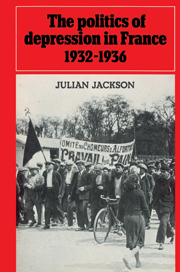Book contents
- Frontmatter
- Contents
- Acknowledgements
- Abbreviations
- Introduction
- PART 1 THE BACKGROUND
- PART 2 THE COURSE OF POLICY: GOVERNMENT AND OPPOSITION 1932–1936
- 4 From le 8 Mai to le 6 Février: the misunderstanding
- 5 Varieties of deflation 1934–1936
- 6 The programme of the Popular Front
- PART 3 NON-CONFORMISTS OF LEFT AND RIGHT
- Epilogue: The politics of rearmament 1936–1939
- Conclusion
- Appendix
- Notes
- Bibliography
- Index
4 - From le 8 Mai to le 6 Février: the misunderstanding
Published online by Cambridge University Press: 02 November 2009
- Frontmatter
- Contents
- Acknowledgements
- Abbreviations
- Introduction
- PART 1 THE BACKGROUND
- PART 2 THE COURSE OF POLICY: GOVERNMENT AND OPPOSITION 1932–1936
- 4 From le 8 Mai to le 6 Février: the misunderstanding
- 5 Varieties of deflation 1934–1936
- 6 The programme of the Popular Front
- PART 3 NON-CONFORMISTS OF LEFT AND RIGHT
- Epilogue: The politics of rearmament 1936–1939
- Conclusion
- Appendix
- Notes
- Bibliography
- Index
Summary
The elections of 8 May 1932 resulted in the greatest parliamentary success for the left since the war: in 1924, the victorious cartel had been dependent for its majority on the votes of the centre–left Gauche Radicale; in 1932, the combined forces of the Radicals (157 deputies), the S.F.I.O. (129) and various independent Socialists, commanded a comfortable majority, although a majority was also theoretically available between the Radicals and the right (259). The results were greeted enthusiastically by Radicals favourable to collaboration with the Socialists: ‘the task now,’ wrote the political correspondent of La Lumière, ‘is to build the bridge which will allow Radicals and Socialists to join together: they are entrenched on the two opposite banks of a river which is not wide’. But on what was this bridge to be constructed? To insist, as did the same writer, that any ‘misunderstanding’ between the two parties would be resolved if the new premier implemented ‘the policy of le 8 Mai’ begged more questions than it answered. The history of the next 18 months was to demonstrate that the river was indeed wide –at least as far as economic policy was concerned. But in retrospect it was clear that the ‘misunderstanding’ could at least be traced back to the election result which was supposed to resolve it.
The elections of 1932
Elections do not often allow one to draw very useful conclusions about future policy but they do offer a privileged opportunity to situate a particular issue among the various preoccupations of politicians and their electorate.
- Type
- Chapter
- Information
- The Politics of Depression in France 1932–1936 , pp. 53 - 79Publisher: Cambridge University PressPrint publication year: 1985

